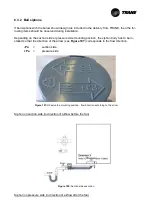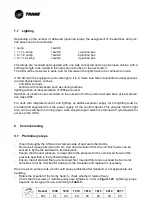
6.4.1 Insulation of fresh air damper
Before connecting the duct section, the flange of the fresh air damper must be insulated in the
course of the fresh air duct insulation on site. This action is urgently required to prevent the for-
mation of condensation by heat transfer.
If fresh air dampers are not integrated in the AHU casing, then also the damper frame must be
insulated.
6.5 Pumps
-
In case of subsequent pump installation has to be noted, that the intake socket is below the
water surface.
-
The pump base has to be set so low, that the suction tub comes to the pump with a decline.
-
For noise insulation, the foundation shall be executed as the AHU itself (refer to
chapter 4.1
).
-
Fresh water supply:
The maximum allowable pressure is 300 kPa (3.0 bar).
7
Electrical connection
-
The electrical connection must be executed in compliance with international regulations such
as the Low Voltage Directive and the requirements of electromagnetic compatibility of national
legislation and the requirements of the local electricity provider.
-
For systems, which operate in hazardous areas, are special provisions for component / equip-
ment design and used materials. For details refer to
chapter 11 (ATEX units)
.
7.1 Connecting to an external protective conductor system
The AHU must be connected to an external protective conductor system. The AHU shall be either:
-
connected at the base frames or
-
alternatively, at the potential compensation, that is mounted on the flexible connection by
TRANE.
-
Furthermore, each electrical component must be connected to the protective conductor sys-
tem.
7.2 AC motors
The three-phase motors fulfill the following criteria:
-
Protection class: IP 55
-
Thermal class: F
-
Type: B3
In thermal class F, the motor can deliver the rated capacity up to
-
a coolant temperature (air temperature in the fan section) of 40 °C.
-
at an altitude up to 1000 m.
At values that exceed from the above, the load is to reduce.






































